Weta Digital. The name is instantly recognizable in the worlds of visual effects. For more than a quarter century, the award-winning visual effects house has created some of the most memorable characters and worlds ever seen on film; worlds that transport us and immerse us and make audience members sit up and go “WOW!”. Led by Senior Visual Effects Supervisor Joe Letteri, it’s because of Weta Digital’s creativity and technical innovation and advancements that we intimately know places like Pandora, Asgard, Titan, Kamar Taj, Contraxia, and Wakanda, among others. We’ve also seen Avengers’ Tony Stark develop his patented Iron Man suits and Hank Pym design suits for Ant-Man and The Wasp, and all thanks to the wizards of Weta Digital. And how about the latest Peter Parker aka Spider-Man iron spider suit? Weta.
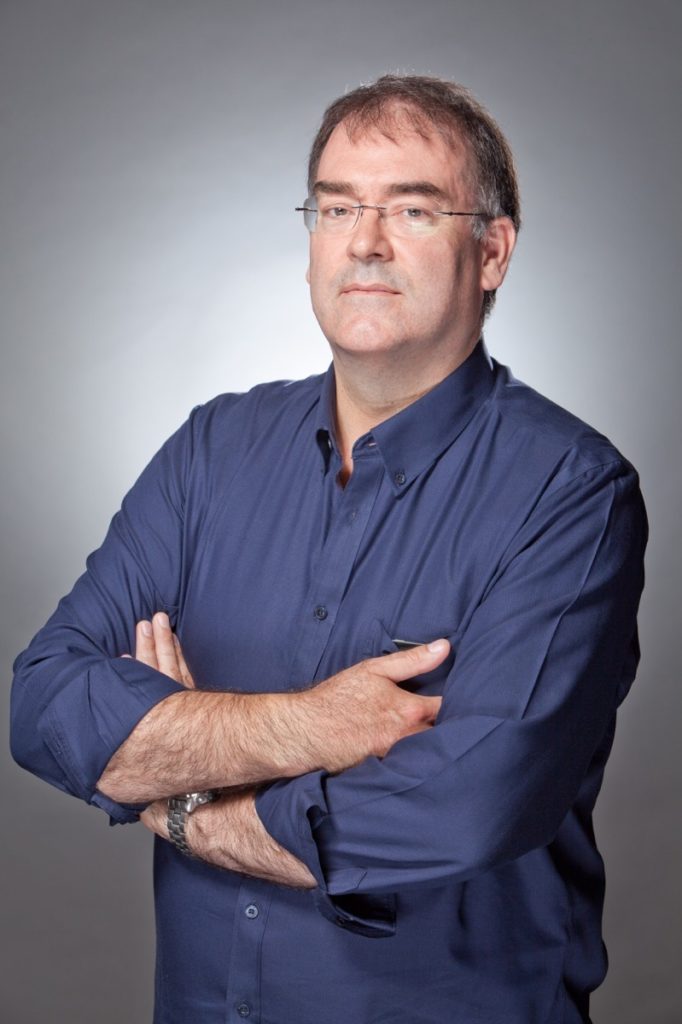
The second artist to join Joe Letteri at Weta Digital was MATT AITKEN. Since coming onboard in 1993, Matt has found himself as a Visual Fx Supervisor on numerous films, most notably, “Avengers: Infinity War” for which he was awarded the Visual Fx Society Award, “Iron Man 3”, “District 9 for which he received an Academy Award nomination, “Tin Tin”, and of course, “Avengers: Endgame.” Matt and Weta have now done visual effects on five MCU films, not to mention making the VFX journey from Gollum all the way to Thanos, the latter of which is the first entirely digital lead character in the MCU. But perhaps one of the most outstanding VFX set pieces to come from Weta is the climactic battle in “Avengers: Endgame.”
While we were all impressed by the Titan battle in “Infinity War” of which 50% of those shots were digitally done by Weta, “Endgame” goes above and beyond thanks to an excess of 13 portals with visible individual worlds within each portal and superheroes emerging from each, many with digital costume also layered in. According to Matt, Weta’s work in the climactic battle scene comes in at approximately 494 digital shots. Mind-blowing, eye-popping, and jaw-dropping, MATT AITKEN was the Visual FX Supervisor responsible for overseeing the masterful work of the ultimate showdown.
Always a joy to speak with any of the master artisans at Weta Digital, it was particularly exciting to sit down in-person with MATT AITKEN and dig deep into the Visual FX of “Avengers: Endgame”. Animated, exuberant, and with the excitement of a kid on Christmas morning, Matt spoke at length about creating the portals, blip lights, wind effects, quantum explosions, animating fight scenes, digital costumes, creating digi-doubles, Thanos, and of course, a sequence within the final battle that had moviegoers cheering – “The Women of Marvel.”
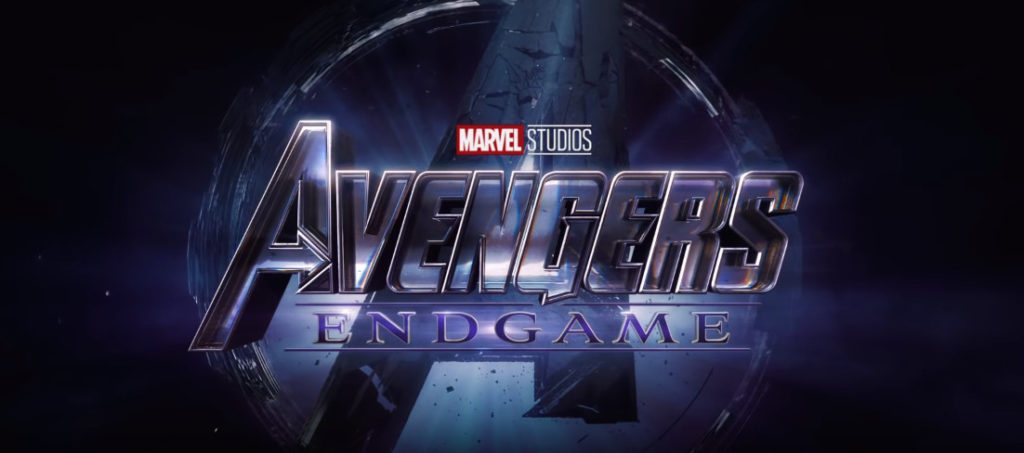
AVENGERS: ENDGAME is visually very dense. It’s also very emotionally dense, moreso than anything else in the MCU. And that’s what I really love with this film. Of course, then with the climactic battle sequences, I was just gobsmacked.
That’s my feeling. But it’s good to hear you say that, too. Yeah. It’s quite dense, right? There’s quite a lot to it. [The finale battle] was the little bit that we contributed. Yeah. But also, there’s emotional beats through there. There’s the portal sequence, for example, where everybody comes back when it looks like all hope is lost. We knew we had to get that right because that was kind of like the emotional payoff for the whole movie. So, we treated that sequence very carefully.
That is one of the most exquisite scenes that I have seen in the tens of thousands of movies that I have seen! How did you and your team actually pull that sequence off because hand-in-hand with the digital, you’ve also got Trent’s [Opaloch] cinematography in there? So, it’s not all digital. We’ve got cinematography and digital working together for much of that.
That’s quite some praise. The cinematography in those shots is that there’s too many actors. Because there’s a lot of cast in those shots, sometimes there’s multiple plates, multiple filmed elements in a single shot. Sometimes that’s just for the practical nature of trying to organize a shoot like that where you’ve got so many lead cast members and trying to just juggle the logistics of getting them all together at the same time. Sometimes that wasn’t possible. So, you might have, for example, in the shot where a portal opens and we see through to Titan from “Infinity War,” and you’ve got Drax and Mantis, and Strange, and Quill, and then Spidey turning up. They weren’t all able to be on set at the same time because those actors are incredibly busy. So, we had different filmed elements for Drax and Mantis, and Strange, and Quill, and Spidey. They’re all different and we had to put them all together in post. You get them all so they all lock together nicely. But the environments themselves, the different places we see through the portals: Wakanda, New Asgard, Titan . . .
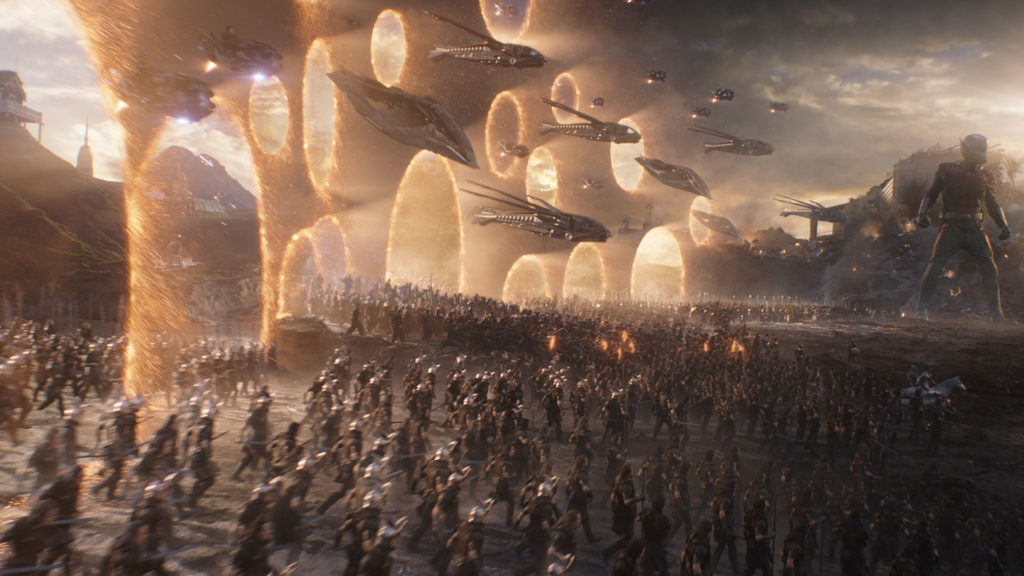
That’s what was mind-blowing to me. Once I got beyond the sheer scale, especially the one shot where all the portals are opened at one time, that is for me, the money shot of the movie. When the portals opened and we see Wakanda back there, and Titan there. And oh, there’s Asgard. It’s not just an “empty” portal. We’re seeing each world from which these people are coming! How do you even tackle that from a VFX standpoint? That is layers upon layers, upon layers of plate.
Oh, that’s a great shot! Except that none of it’s plate for that stuff. It would be so hard to get everything to line up correctly. So, the only way that we can really do that successfully is by creating all those environments entirely as CG. So, we’ve got our hero camera that we’re typically we’re crafting, sometimes it’s a plate camera for when we’ve got the lead actors like Cap or, like I said, the guys coming from Titan or whoever’s turning up; there’ll be a camera on them. That becomes our camera for all the environments, as well. And in the big wide shots, that’s a CG animated camera that our animation department has crafted from scratch to look like cinematography. So, we’re going to use those cameras or digital versions of those cameras to render, we call it, the CG worlds within the portals. And that’s the only way that those shots are going to lock together and feel coherent and cohesive. So, we have a team we called our Digital Matte Painting Team. And their role is to craft out of three dimensional CG, all those different worlds and make them look photo real. So it’s as if you’ve gone to Wakanda, or you’ve gone to New Asgard. And we’re referencing plate photography, but we’re actually creating a CG version of the worlds. So, like I said, we can render it through that one unified camera and it all lines up.
Then, of course, you add your portal on top of that. And then you get into, for example, when you’ve got Spider-Man down in the foreground, you’ve also got to worry about his costume, because that’s totally CG.
That’s right. Yeah.
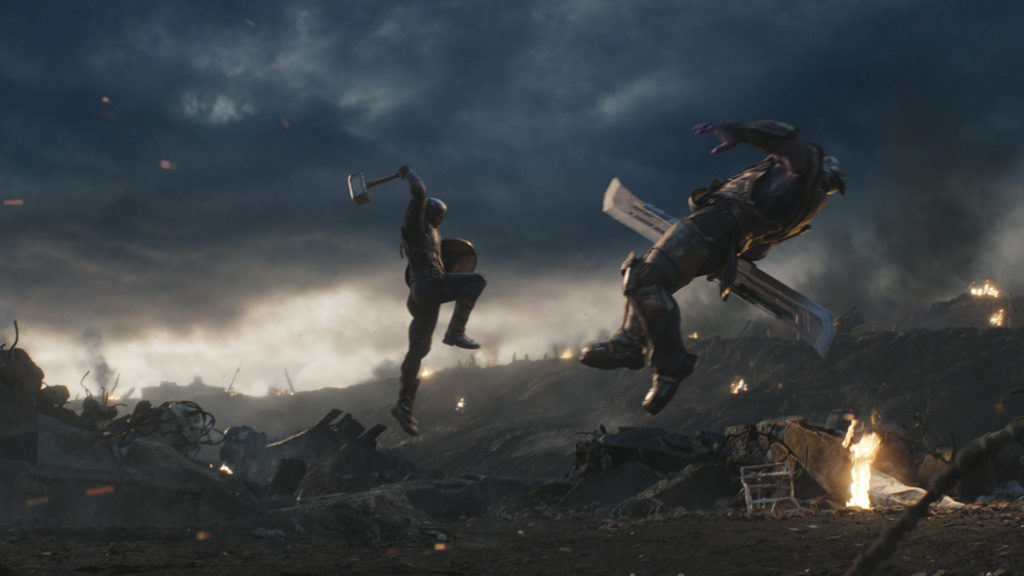
You’ve got so many moving parts here. Where does it start, Matt? Does it start with the background? With the digital matte background? Does it start, once you have your hero cameras? What’s that process?
For us, the starting point will always be within our animation department. We’re getting reference from the production. We’re getting reference from Marvel. We’re getting filmed elements from them. We’re often getting previz from them, as well. So, they used a company called the Third Floor to previsualize some of these scenes, to kind of a semi-rough level. It all comes together with our animation department. So, they will have a representation for each of the portals. They’ll have the filmed elements. The plates will be in their scene as reference. They actually worked off very simple versions of the portals themselves. They weren’t doing all the sparks and everything flying around but they had, essentially, a circle in the scene that represented where the portal was going to be placed and also the timing of it opening. I think the timing is important to the emotional resonance of the scene. You know? We worked really carefully on the opening shot where the three heroes, T’Challa, Okoye, and Shuri, come out of all that kind of glare and mist of Wakanda. We’re not even sure what we’re seeing at first. We worked with Marvel really carefully on that to really play to the emotional significance of that moment.
Even in the press screening, at that one moment when we finally got to see that it is T’Challa there, even the press erupted with applause and some cheers.
Oh wow! You guys are pretty hard-nosed a lot of the time so that’s pretty gratifying. That means that the payoff was there.
Absolutely a payoff. But it was also holding that beat and that’s something that I appreciate even more so with this film because with the VFX, with the digital work that you’re doing, your team is doing, those emotional beats are there.
Well, that’s great. That’s so good to hear that. I mean, we knew that the work had the potential to carry a huge amount of emotional payoff for the audience. We were very careful to make sure that the work supported that. It would have been devastating if that potential had been denied by distractingly not great visual effects, by something wrong with the visual effects. You know, it could have so easily deflated that moment. So, we worked through the whole of the time, the period of time that we were in production on the show, the portal sequence was the first thing we started. And it was some of the last shots that we finished. Not quite the last shot to finish. That was the shot of Tony snapping. That was the last shot we finished. But getting close to being the last stuff that we finished.

A big part of the sequence is also The Women of Marvel. When all the female, and then when you got Pepper coming in her “Iron Woman” suit, that was another huge element. You’ve got Valkyrie flying in. Pepper flying in and obviously her suit is entirely CG just like Iron Man and Spider-Man.
Yeah, rescue suit. Exactly. I think there might be four CG suits in that shot because Captain Marvel’s suit’s entirely CG and Spidey’s in the shot at the start. His suit’s entirely CG. Valkyrie’s actually what we call a digi-double. She’s entirely CG. She flies in and lands and then we, hopefully, seamlessly, handoff to a plate element of her, Valkyrie. So, Wasp pops up. She’s CG through that. That was a great shot to do. It was incredible being on set when that was being shot. The incredible stage presence of that group of actresses was just fantastic to behold. And we really had a lot of fun on the sequence that followed, which is where they’re all collaborating and supporting each other to help Marvel, hopefully, get the gauntlet to the van, to get the stones back to where they came from.
It was like watching a football game. Pass to this one. Pass to that one. Diving under. You know, this one’s quarterbacking. This one’s playing block and tackle. It was amazingly choreographed.
Oh, thank you! We contributed even more to that sequence than we typically do. That sequence came together very late in production. By the time it was ready to kick it off, the team that Marvel uses to previsualize these sorts of sequences had actually moved off the show, onto other work. So, they called us and said, “We need you guys to previsualize that. This is the rough idea of the beats of action that we thought it would go through.” So, our animation supervisor, Sidney Kombo, and his fantastic team just brainstormed out all these gags, all these ideas. The idea that Thanos is going to come in and try to intercept Captain Marvel and then three of the backup team come out and send him tumbling. And just when you think she’s going to make it, he throws the blade into the van and it explodes. Yeah, we pre-vized all of that. We actually cut that all together. We did a rough assembly of it. We sent that through to production and the production editor, Jeff Ford, did a pass on it, which was great ’cause he actually trimmed a couple of shots out, tightened it up. And that was what we went to town with. But that was all quite recently that we were doing it.
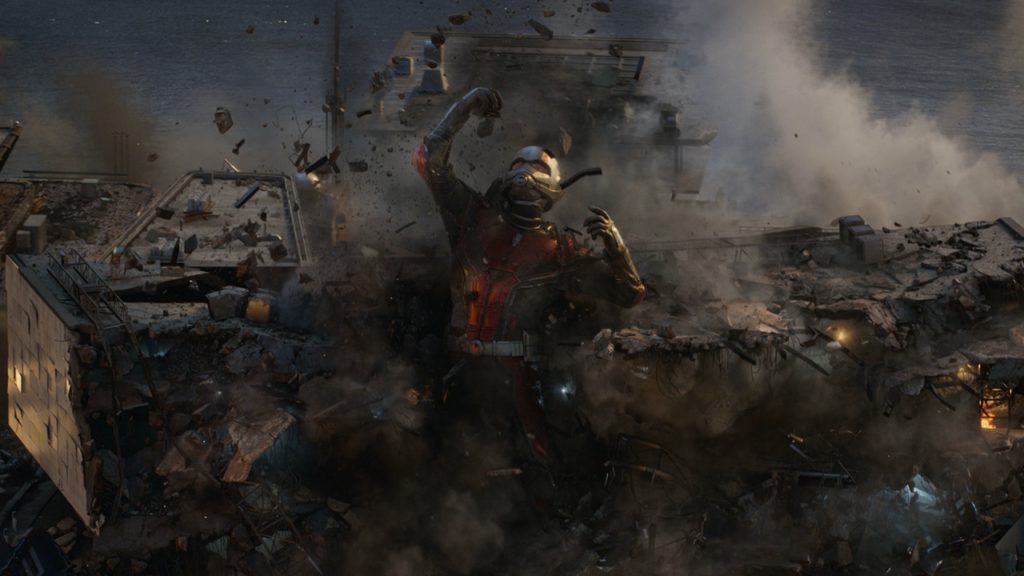
Wow! How recent before the film opened were you doing that?
We were basically pre-vizing that sequencing in February. And then finishing it up in March. We delivered our last shots in early April. I can’t remember what exact date we finished on but it was into the second week of April that we were still working on the show. I think it’s about everybody wanting it to be as good as it could possibly be. And that’s about really pushing it to the limit of how late you can go and still not compromise the quality. It’s just about making it better. The modern digital post-production workflow, when everything is well organized, which obviously with Marvel, it’s going to be extremely well organized. . . I think they were in the grading suite and they were still dropping in updates to visual effects shots so that things could be plussed a little bit here and there.
How early did you and your team get involved with this? Or was there no real start and finish because you were also doing “Infinity War”?
We just rolled through with “Infinity War” and into pre-production on this one. I suppose, really, the show got underway for us though after they did a block of additional photography up at Pinewood Atlanta in Georgia, sort of from mid-September to mid-October of 2018. They had shot out most of both films right through 2017 and then they really focused on the first one, obviously, from the start of 2018 through till late April when it opened. Once the dust had settled on “Infinity War” they circled back and started to look at what was still required to finish up “Endgame.” And that was when they scheduled this block of additional photography and it turned out that that was almost exclusively the third act battle that they were shooting at that time. I was up on set throughout that five-week block. Then they did some post-viz on that. And they cut it. And that was really when we got going on it properly. But we were doing a lot of what we call “asset building” in the lead up to that. We had a lot more digital characters this time than “Infinity War.” Looking back on “Infinity War”, when I look at the asset list, because we were just on Titan there’s a very small group of characters there. There was the environment and we built the environment for both these shows. For “Endgame”, as we discussed, we had to build all these environments. We had to build the bombed out crater. We had to build an intact compound because we did the attack sequence when Thanos destroys the compound. But then we’ve got all these other environments that we see in the portals, as well. So, that and pretty much every character who’s ever appeared in an MCU movie, pretty much, I would say, are all there.
Because of the layers of work that you have to do, the costumes, the completely digital costumes for Iron Man, Spider-Man, for Pepper. Now they have advanced. Weta has now done … this is the fifth MCU film. I think “Iron Man 3” was the first one where Iron Man’s suits were really taking on a very advanced look and design. And it’s just gotten more and more intricate, more and more powerful, more and more beautiful.
True. The tech keeps evolving. There’s Tony Stark. He likes tinkering with the suits. Like you say, we saw that in “Iron Man 3” with the huge number of suits that he created. We got to work on that. We kind of had a really nice, kind of like, path of experience working through the different Iron Man suits. Our first Iron Man show was the original Avengers film. And the suits were digital then. I think the way that they’ve evolved in the MCU, they were sort of like a mixture of digital and practical in the first film, in “Iron Man 1”. But it’s quickly evolved until the suits were all entirely digital. We hope it’s invisible work. We hope that people aren’t even aware that we’re doing it. But it’s some of the most technically demanding work that we can do because it has to move completely believably with the actor who’s supposed to be wearing it. If there’s just a little shimmy around the neck, it’s going to look very strange. So, it’s actually some of the more painstaking work that we have to do. The approach that we take, in brief, is we have to do what’s called a “match move” of the actor. . . Let’s say we’re talking about putting an Iron Man suit on Tony Stark, for example. We’ll take the footage of Robert Downey Jr and we’ll match animate a digital version of him that has to, kind of, exactly replicate what he’s doing. And then we can put our digital suit onto that digital Robert Downey Jr, and render that, and light it, and make it feel like it’s completely integrated into that environment. Render it with a copy of the camera that filmed the actor on set. And often, with a lot of these shots, all we’re keeping out of these filmed elements is just the actor’s head because we’re going to replace the environment. We’re going to put a CG environment around them. We’re going to put a CG suit on them, their weapons. Thanos and his army, they’re all entirely digital.

And Thanos is the first character in MCU to be totally digital.
Yeah. He’s really the first time that they got into a digital character who’s like a lead player in a film. They’ve done Rocket and Groot. But Thanos, he he had to work. And on “Endgame”, he’s come to the era of “Endgame”, which is 2024, effectively, when he comes forward in time. He’s learned what happened to the Thanos in “Infinity War”. He’s a bit pissed, what with the plan to kill off half the life in the universe. He’s going to kill off everybody in the universe. He’s going to rebuild the universe from scratch. As always with Thanos, he never loses his cool. He always feels like he’s completely in control. But there’s this sort of seething emotional undercurrent there that we had to play out that he’s kind of over dealing with these guys. So, he’s much more of a threat this time. He’s also a younger Thanos ’cause he’s come forward from 2014. So, he’s more at the peak of his physical prowess. So, when they’re fighting him, he’s a daunting physical presence to deal with. And we had to get all that right, as well.
And it works beautifully. I’m sure for Trent and his camera people when they’re actually filming before it goes to your hands, they’ve really got to get that camera dutching right because of the imposing figure of Thanos.
Oh yeah! No, they did an amazing job of getting all that right. They used a variety of different techniques on set. We had Josh Brolin with a cardboard prop Thanos head to give it the eight feet of height if he is moving around. If he’s actually standing still and just talking, we’ll put him on a platform. We’ll put him on a riser and just get the outline match that way. Sometimes, if there’s close physical interactivity between Josh, and sometimes it was a stunty, you know if it was the fight scenes, it might be a stunty standing in for him, we got to bulk them out so when Cap or Thor, or Iron Man are interacting with him, their arms are sitting in the right place. So, there’s a lot of shot by shot development work going on, just working out what is the best way to shoot it. And every shot is a little bit different. There’s no kind of rules for that stuff.
You mentioned one of my favorite details in every film, be it digital, be it practical, eye line. Matching that eye line. Lensing that right. Because here there are so many instances where we’ve got an extreme closeup onto a profile and we get the reflection in the eyeball of what … There’s a great scene with Cap and it’s a reflection of what he’s look … and the camera picks this up. But this eyeline is so key to establishing the emotional relationships between everybody and the intensity of what they’re feeling. How challenging is it, especially in these battle sequences, to get the eye line right, digitally?
Very challenging. That’s something that we will spend a lot of time on because, as you rightly point out, it’s crucial. It will immediately fall apart and just feel completely fake. I don’t know what it is about us as an audience, but we are very perceptive about that. I guess it’s just an innately human thing that we know when it’s right and we know when it’s wrong. So, that’s something, because a lot of these characters are digital, we do have control over this. So, for the live-action characters, we can put Thanos in the right place, so that’s really, really working. Sometimes our heroes are digi-doubles, as well. So, we’ve got control over that stage. Yeah, we know when it’s wrong and we work hard to get that right.

You definitely got it right here because we get even more invested with these characters, especially, when you’re picking up Jeremy Renner as Hawkeye because Jeremy is so intense. No matter who he’s looking at, whether it’s in digital sequence, whether it’s in a practical set, he is so intense with those eyes, just staring you down.
Oh yeah. We did Renner shots with him when he’s, to use your nice football analogy, he’s the quarterback. And he’s running forward and he’s about to be overcome when Black Panther comes to his rescue. So, they have a nice little bit there.
Black Panther, you don’t really have to worry about an eyeline with him because of his mask.
Which is often digital because it’s got to come and go. You know? He’s actually the one suit that we didn’t have to replace. I like that suit. Everybody was happy with it. It looked great on him. So, the suit stayed. But obviously, his helmet comes and goes. That’s often digital. And then, he’s a digi-double in the wide shots. We did a big clash shot when the two armies are running together and, as part of that sequence, there’s a shot which starts out quite close on Thor and Cap running, Iron Man’s flying above them. The camera pulls back and we see the whole amassed army. It was actually a stunty playing Black Panther in that plate. Maybe he couldn’t see because of the helmet, I’m not sure, but he was really fast. He was a fast runner. He just outstripped everybody and cleared out of frame when there was still frame to put everybody else. So, we just had to paint him out of the plate and replace him with a digital-double. So, he stayed level with everybody else.
When it comes to all of these costume designs … for Spider-Man, this version now, with the legs popping out, and with Iron Man’s, do you get the designs from the costume designer, or how much freedom do you have to actually work on the look and design of the costumes, especially when it comes down to lasers shooting out of arms and things like this.
That’s actually a really good point. Typically what happens is we get concept art from the productions. So, they’ll have 2-D artists in Photoshop or something like that working out different takes on what the suits would look like. That’ll get reviewed with the filmmakers and the studio and they’ll settle on a look. And that concept art will get passed to us and we’ll work it up. In the case of Iron Man, for this film, it was a collaboration between us and ILM, another facility who worked on the show. We will work it up into what we call “three dimensional CG”. The broad brushstrokes of the design of the suit are there in the concept art, but there’s a lot of detailing that has to happen. That’s where we spend a lot of time making sure this thing will react to the light correctly, that it will have the right material characteristics, or it feels like it the right tech. And then, as you say, like Iron Man’s suit, it has the bleeding edge tech, so it can generate all these different weapons. That’s an area where we get a lot of freedom to contribute to the design. So, it’s immensely satisfying. You can’t believe how satisfying it is for our digital models department to see the designs that they have created and often changed and worked up in multiple design iterations with Marvel until we’ve settled on something everyone’s happy with. When they see that turn up as a plastic toy or as a collectible, they’re often the first people to buy those, ’cause they’re so excited to see their work come through in that sense. That’s an area that we do have quite a lot of contribution to.
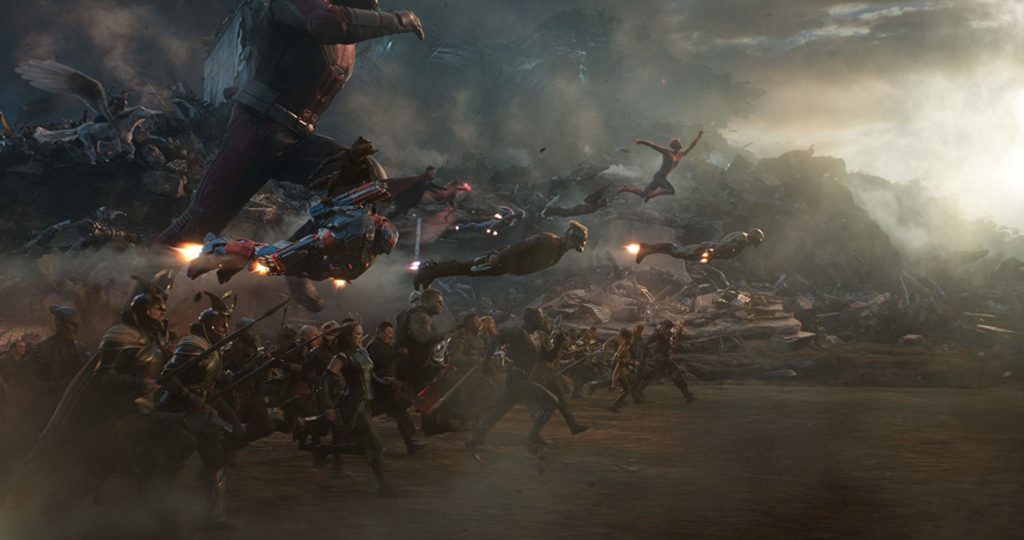
How difficult is it achieving the textures of these costumes for the light reflection and refraction because the fact, it is, “metal”? It should be shiny. And then with Pepper’s costume, it’s that gorgeous, gorgeous blue which creates a whole different light reflection and refraction. . . So, I’m curious, how challenging that is for your department. It’s not just establishing portals and worlds, you’ve got to worry about how sunlight, how natural light, how focused light is going to react and look.
For sure. And there’s a team at Weta who really just focus on that one aspect of the work. They’re working on a very highly technical level. The way I think of what the shadow department does is they’re writing computer programs, they’re writing software, that mimics the way light reacts with materials, as you say, different materials. Often they’re getting incredibly technical and really doing a lot of real-world physical-based lighting. They’re modeling their behavior in their software. But there’s an aesthetic component to it, as well. With Iron Man’s suit, there’s this kind of like, continuum. The surface of a really high-end sports car at one end of this continuum. And then there’s iron, steel, base metals, at the other end. And he has to exist somewhere on that continuum. His suit has to have components of both of those. But if it’s too much one or other, it won’t be right. So, we spend a lot of time balancing out all those different criteria, like how much of the sun’s color is reflected in the light reflection?s Or how much of the material’s color is reflected in the light reflections? There’s a lot of balancing that goes on there.
It’s a real standout when he’s on Titan because of the way the sun is and the orange glow and the way that’s hitting the suit.
Oh, no, you’re right! We had to a lot of balancing there because there’s a very warm sun on Titan and if we had allowed that to play fully, he would have been almost fluorescent. We had to kind of tone it right back, to work under those conditions. If you took the Titan Iron Man suit and popped it into an average day on Earth, it would like quite dull by comparison, because we’ve done that compensation. So we’re balancing it all the time. We have to do that with Thanos’ skin, incidentally, as well.
It’s an interesting skin tone. It’s not even purple-purple. It’s kind of a lilac or a mauve. It reminds me of an Adrienne Arpel color wheel foundation make-up kit with yellow primer, anchorwoman blue, lavender, beige.
You’re right. You’re right. He’s reacting very much to the different light colors of Titan in the first film or this kind of overcast, smokey, fiery, atmosphere that we’ve got playing in the bombed-out Avenger’s compound in “Endgame”. We’re constantly having to dial his skin color to work under those conditions, as well, because we want it to be recognizably Thanos. . .should we call it lilac? Thanos Lilac? I like that. Yeah.
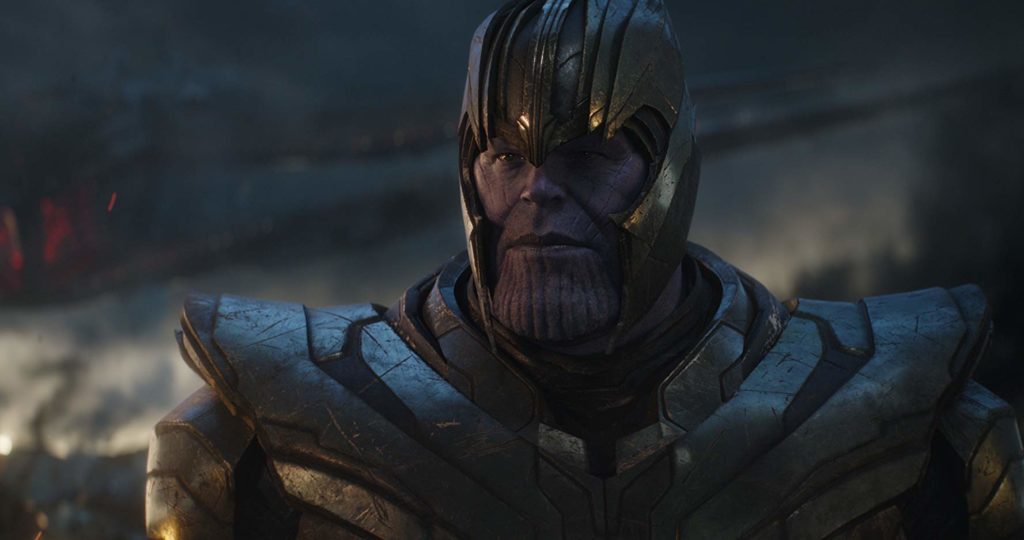
The color of Thanos’ skin is like the whole color wheel all put together.
Right. He’s not just like you’ve caked him with lilac makeup because that would be, essentially, very superficial. Thank you, very much observing that. It means we’ve succeeded in this goal that we had which was to make it feel like it’s very natural skin, natural flesh tones, but with a purple, such lilac, such mauve cast to it. It’s a bit of a balancing act because it could have felt artificial very easily. But then he had to be recognizably Thanos, as well.
And of course, it also picks up all the colors of the Infinity Stones.
Very nicely. It sets them off very nicely.
How important are the technological developments to your work? And any changes that came along while you were working on “Endgame” that aided and enhanced what you could do? I know you have a huge R&D Department.
Yeah. We are continually updating our techniques and approaches. We have multiple projects happening at the same time. We have a huge R & D department. I think of them as the crown jewels in our team because they are constantly coming up with tools for us to use on these shows that enable us to do what nobody has seen before. It’s still very much that is the case in this game. Even though the industry has matured and there’s been a lot of consolidation in terms of the approaches that we take, there’s still fantastic stuff going on in R & D. That means that the quality of the work that we can produce just keeps getting better and better. We were using some new approaches on Thanos to add more fine detail to his facial performance. There was definitely developments going on in our lighting pipeline so we were able to render very complex environments more efficiently. There’s a lot, a lot at work there.
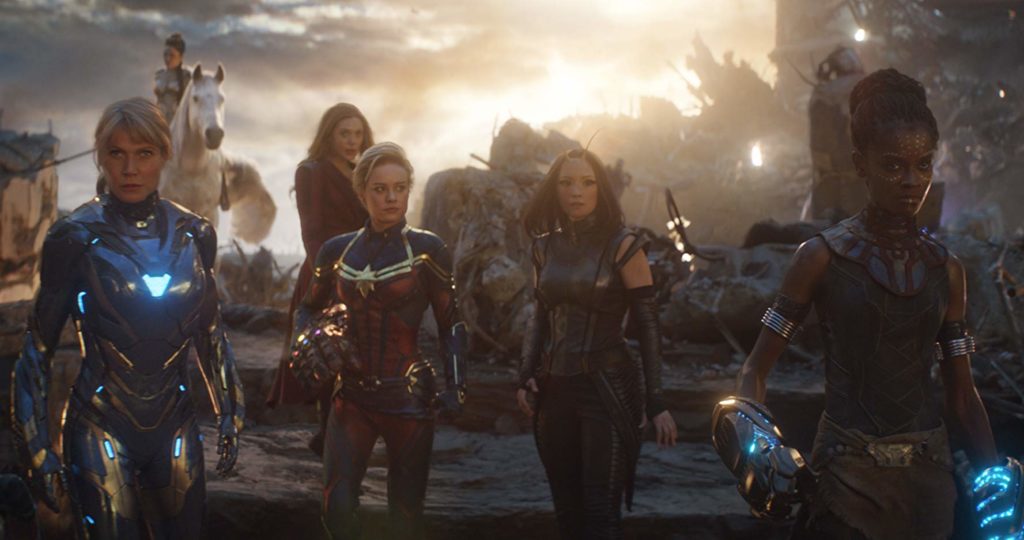
Does that impact your timeline working, as this stuff is entering the pipeline while you’re in the middle of a project?
No. There’s a certain point in the show where we have to say, “Love what you’re doing there, guys. We’re just going to have to save that for the next one because we’re gone to lock down our suite of software for this show right now and just finish the show.” But we can do that quite late. Typically, maybe three or four months from the end of a show is when we’ll go into lockdown, in terms of the software department.
And with “Endgame” you were still working two weeks before the film’s opening. You really pushed this envelope!
Yeah. I know. I know.
How many digital shots did Weta do in “Endgame”?
Our total set of work was just under 500, I think. It was 494 was the count that I have. So, of those, I would say about 33, 34 percent of them were entirely digital. There was no filmed element, which is a higher percentage than usual. Usually, on these sorts of films, digital are roughly 25 percent. Around a quarter of the work will end up being fully CG, and three-quarters will be plate-based work with maybe with some addition of some digital characters or suits, or environments, or effects, or whatever. But this scope of the battle, those giant shots of the armies clashing, shots where we’ve got Thanos fighting Scarlet Witch and they’re both digital because of the nature of the action that’s going on.
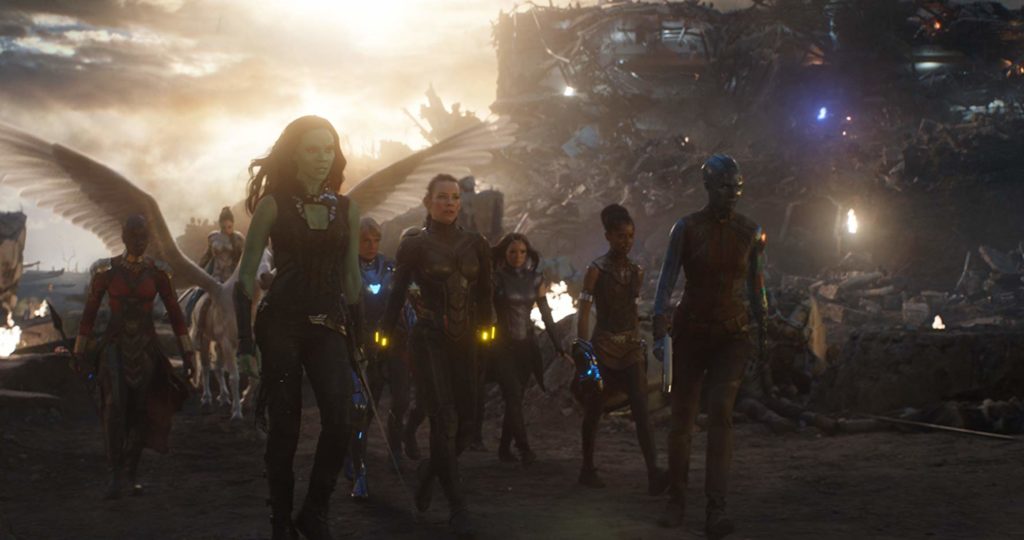
And you really upped the ante with Scarlet Witch this time. Those fireballs and then the levitation, and the way that red permeates like a blanket lifting.
That is true. Yeah. She’s fantastic! We worked on that a lot. That was hard. That wasn’t trivial to achieve that. The idea that we were playing to since we first met her in “Ultron”, she’s been getting to know her powers and becoming more proficient with them and just getting more and more powerful, really. We saw her in “Infinity War” in shots that weren’t actually active in, but you saw her at the end there, essentially, destroying the stone and Vision. The mind stone. Her powers have definitely grown since when we first saw here. But then that developed even further now. Also, she’s angry. She’s incredibly upset that [the love of her life] has just gone. In her timeframe that all happened five minutes ago so the way that we see her demonstrating her powers in “Endgame” is next-level. And she’s actually triumphing over Thanos! She’s dealing to him. As you say, she’s got him up in the air. His armor is being destroyed off him. Actually, Dan DeLeeuw, the Marvel Production side Visual Effects Supervisor sent us some great frames from the comics of Scarlet Witch with her powers at full strength which we used as one of the starting points for kicking off that work. That was very satisfying work to do.
Gotta ask, Matt. Favorite moment in the film?
Got to be the portal sequence. The emotional payoff on that scene was wonderful, was just incredible. We did a lot of great work. We did Thanos’ army disappearing. You know, that was great fu! We did a re-hero, hero, what we call a “blip”. You know when Thanos turns to dust? That was so carefully crafted that was the best blip that we’ve done, of all of them that we’ve done. And the incredibly touching and incredibly sensitive stuff we did where we see the after effects of Tony’s snap and the effect that’s had on him and ultimately the scene where he dies, which just even say that … you know. There was a lot of key stuff that we got to work on because of the range of the shots that we were working on in the film. Yeah, the portals. I’m going to keep coming back to that scene. That was so satisfying.
Favorite character?
Can’t say! It’s like being asked to name your favorite child. You know? There’s so many great characters. Iron Man. He’s the reason for the MCU. We’ve got great work with him over the years. Fantastic doing some work with Rocket. I love Rocket. He’s such a great character. The contribution that Bradley Cooper makes to him, I think is huge, personally. Just awesome getting to be involved in that. But there’s just so much going on. Being able to collaborate with Josh Brolin on Thanos. Thanos and Weta are kind of inextricably linked now for all time. So, yes, that has been an amazing thing to be part of.
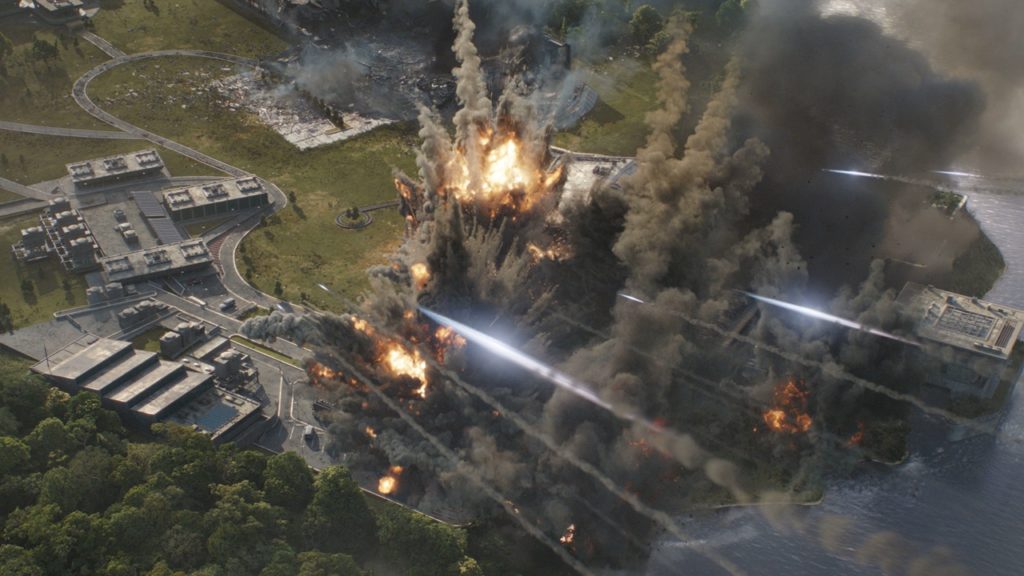
Now that the film’s already made over two billion dollars, it’s out there, and the whole world is loving it, what did you take away from working on, not just this project of “Endgame”, but the MCU films that you have gone on this journey with to get to this point today? What have you learned about yourself and taken away that you can now take into the next phase of MCU?
Wouldn’t that be wonderful? I could only hope that that’s going to happen. These are great films to work on. These films, they’re incredibly demanding. They stretch us in ways that we don’t get stretched on other shows. But so satisfying to work on these. And part of that is just that you know you’re going to make something that’s going to make a connection with a huge number of people. These films connect at a fundamental level. Somebody said that these are the cultural phenomena of our time. It’s really kind of mind blowing for me, personally. And I’ve been in this game for a while. I would have thought that having had been involved in the “Lord of the Rings” trilogy that up until a few years ago I might have thought that, in terms of a lasting legacy of visual effects work, with all the shows I’ve worked on, and I’ve worked on fantastic shows, maybe “Lord of the Rings” was going to be the thing that I tell it to my grandkids, was the thing that was the lasting legacy of my visual effects work. But now I have this experience where I’ve been involved in these touchstone films, particularly the last two, “Infinity War” and “Endgame”, and we’ve had the opportunity to make a really significant contribution to those films. It’s kind of like, maybe lightning does strike twice. I’ve had an incredible experience on them.
by debbie elias, exclusive interview 05/05/2019












